Monitor "MAPS" status on the service data.
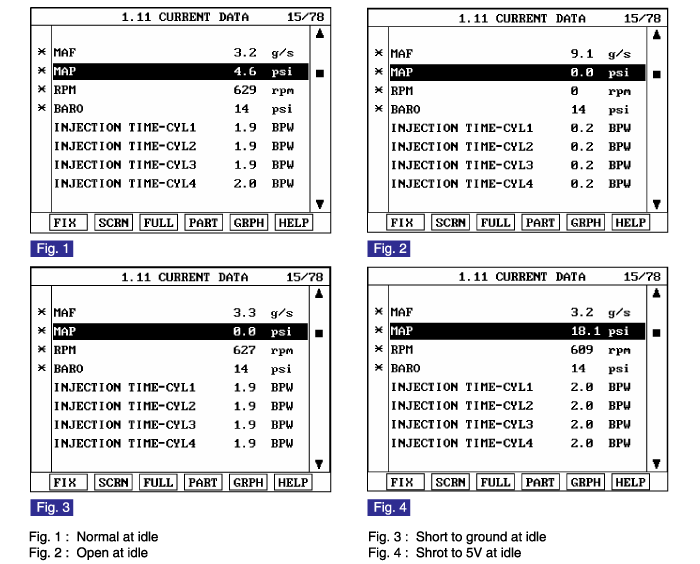
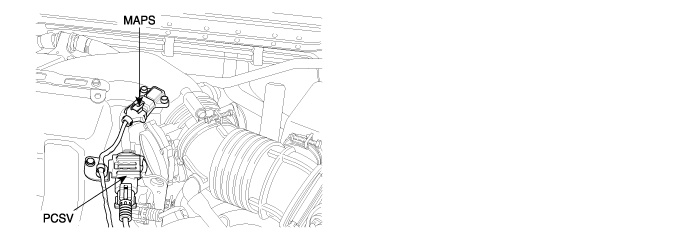
The amount of intake air flow must be inputted to PCM in order to determine the fuel injection quantity. MAPS(Manifold Absolute Pressure) calculates the amount of air indirectly as measuring the pressure inside of intake manifold. This mechanism is also called Speed-Density Type.MAPS transfers analog output signal which is proportional to the change of intake manifold pressure, then, with this signal and RPM, PCM calculates the amount of intake air flow. MAPS is mounted on surge tank to measure the pressure inside of intake manifold, and it consists of a piezo electric element and hybrid IC which amplifies output signal from the element. A piezo electric element is a sort of a diaphragm using piezo electric effect. One side of the diaphragm is surrounded with vacuum chamber while intake pressure is applied to the other side. Thus, signals are outputted by the transformation of diagphragm according to the change of pressure inside of intake manifold.
PCM compares the MAPS output and calculated MAPS value while enable condition ismet. If the acutal MAP value is higher than Maximum threshold or lower than Minimum threshold for 15 secondfailure during one diagnostic test(32 second),PCM determines that a fault exists and a DTC is stored. MIL(Malfunction Indication Lamp) turns on when the malfuction lasts till cosecutive 2 driving cycle.
Item | Detecting Condition | Possible cause | |
DTC Strategy | ● The MAP reading is compared to expected MAP high and low limits based on engine speed & Throttle Position | ● Poor connection ● Open or short in harness ● MAPS ● PCM | |
Enable | Case 1 | Power conditions ● Engine running ● Disabling faults present ● Power stable conditions present ● 1300rpm ≤ Engine speed ≤ 4000rpm ● The minimum consecutive time 〉 1.5 s | |
Case 2 | Deceleration conditions ● Engine running ● Disabling faults present ● Transmission torque convert clutch condition stable ● Decel stable conditions present ● 1200rpm ≤ Engine speed ≤ 4500rpm ● Trottle position 〈 7.9% ● Vehicle speed ≥ 30kph ● The minimum consecutive time 〉1.5 s | ||
Threshold | Case 1 | Power Test ● Altitude compensated MAP 〈 Memorized min. MAP data ● Altitude compensated MAP 〉 Memorized max. MAP data | |
Case 2 | Deceleration Test ● Altitude compensated MAP 〈 Memorized MAP data | ||
Diagnosis Time | ● Continuous (More than 15 seconds failure for every 32 seconds test ) | ||
MIL On Condition | ● 2 driving cycles | ||
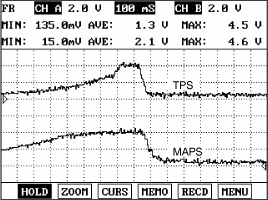
It is necessary that MAPS should be checked along with TPS. Because The MAP/TPS Rationality Diagnostic is comprised of two tests. A deceleration test is performed to provide a robust method for detection of an altitude compensated MAP value that is too high for the deceleration condition. The second test compares the altitude compensated MAP value to both high and low limits, dependent upon throttle position and engine speed. When the MAP value is out of the threshold range, the MAP/TPS system is determined to be failed.
Pressure (kPa) | 20 | 35 | 60 | 95 | 101.32 | ||
Voltage (V) | 0.789 | 1.382 | 2.369 | 3.75 | 4 | ||
Tolerance (V) | ± 0.045 | ||||||

IG "OFF" & connect scantool.
ENG "ON" and warm -up the engine to normal operating temperature.
Monitor "MAPS" status on the service data.

Are the "MAPS" data displayed correctly ?

▶ Fault is intermittent caused by poor contact in the sensor’s and/or PCM’s connector or was repaired and PCM memory was not cleared. Thoroughly check connectors for looseness, poor connection, ending, corrosion, contamination, deterioration, or damage. Repair or replace as necessary and go to "Verification of Vehicle Repair" procedure

▶ Go to "Terminal and Connector Inspection" procedure
Many malfunctions in the electrical system are caused by poor harness and terminals. Faults can also be caused by interference from other electrical systems, and mechanical or chemical damage.
Thoroughly check connectors for looseness, poor connection, bending, corrosion, contamination, deterioration, or damage.
Has a problem been found?

▶ Repair as necessary and go to "Verification of Vehicle Repair" procedure

▶ Go to " Power Circuit Inspection " procedure.
IG "OFF" and disconnect MAPS connector.
IG "ON" & ENG "OFF"
Measure voltage between terminal 2 of MAPS harness connector and chassis ground.
Specification : Approx. 5V
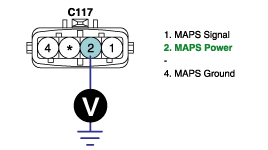
Is the measured voltage within specification ?

▶ Go to "Ground circuit inspection" procedure.

▶ Repair open or short to ground in harness and go to "Verification of Vehicle Repair" procedure.
IG "OFF" and disconnect MAPS connector.
Measure voltage between terminal 2 of MAPS harness connector and chassis ground.
Measure voltage between terminal 2 and 4 of MAPS harness connector.
Specification : Voltage difference between Measurement "A" and "B" is below 200mV.

Is the measured voltage within specification ?

▶ Go to "Signal Circuit Inspection" procedure.

▶ Repair contact reistance or open in harness and then go to "Verification of Vehicle Repair" procedure.
Check voltage
IG "OFF" and disconnect MAPS connector.
IG "ON" & ENG "OFF"
Measure voltage between terminal 1 of MAPS harness connector and chassis ground.
Specification : Approx. 0V
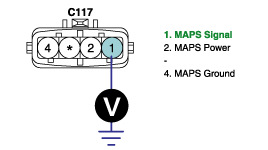
Is the measured voltage within specification ?

▶ Go to "Check open in harness" as follows.

▶ Repair short to battery in harness and go to "Verification of Vehicle Repair" procedure.
Check open in harness
IG "OFF" and disconnet MAPS and PCM connector.
Measure resistance between terminal 1 of MAPS harness connector and terminal 8 of PCM harness connector.
Specification : Approx. Below 1 Ω
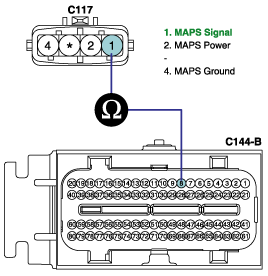
Is the measured resistance within specification ?

▶ Go to "Component Inspection" procedure.

▶ Repair open in harness and go to "Verification of Vehicle Repair" procedure.
Check MAPS Performance
IG "OFF" and install scatool.
Connect probe to MAPS and TPS to check signal waveform by using oscilloscope function.
ENG "ON" and monitor signal waveform during accelleration and decelleration.
Pressure (kPa) | 20 | 35 | 60 | 95 | 101.32 | ||
Voltage (V) | 0.789 | 1.382 | 2.369 | 3.75 | 4 | ||
Tolerance (V) | ± 0.045 | ||||||
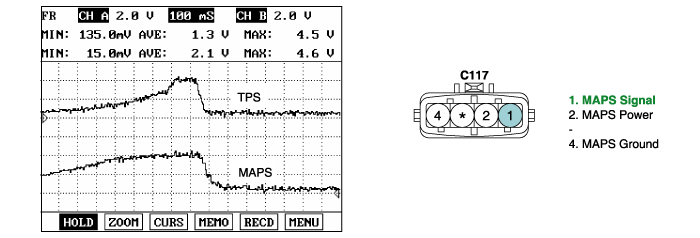
Is the measured signal waveform(MAP/TPS Rationality) O.K ?

▶ Go to "Check PCM" as follows.

▶ Substitute with a known - good MAPS and check for proper operation. If the problem is corrected, replace MAPS and go to "Verification of Vehicle Repair" procedure.
Check PCM
IG "OFF" disconnect MAPS connector
Connect Scantool and IG "ON" & ENG "OFF"
Select simulation function on scantool.
Simulate voltage at terminal 1 of MAPS harness connector.

Does the signal value of MAP sensor change according to simulation voltage ?

▶ Thoroughly check connectors for looseness, poor connection, bending, corrosion, contamination, deterioration, or damage. Repair or replace as necessary and go to "Verification of Vehicle Repair" procedure.

▶ Substitute with a known - good PCM and check for proper operation. If the problem is corrected, replace PCM and go to "Verification of Vehicle Repair" procedure.
There is a memory reset function on scantool that can erase optional parts automatically detected and memorized by PCM. Before or after testing PCM on the vehicle, use this function to reuse the PCM on the others
After a repair, it is essential to verify that the fault has been corrected.
Monitor and record the Freeze Frame Data for the Diagnostic Trouble Code(DTC) which has been diagnosed.
Using a Scantool, Clear the DTCs
Operate the vehicle within conditions noted in the freeze frame data or enable conditions
Monitor that all rediness test have been verified as " Complete "
Are any DTCs present ?

▶ Go to the applicable troubleshoooting procedure.

▶ System is performing to specification at this time.